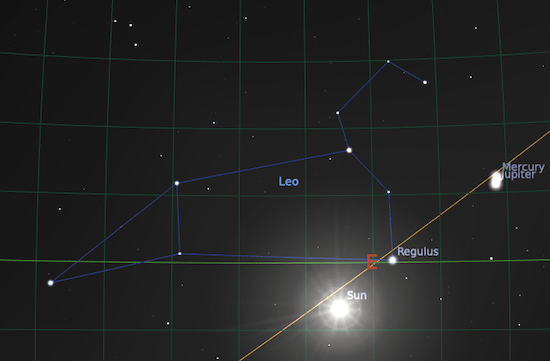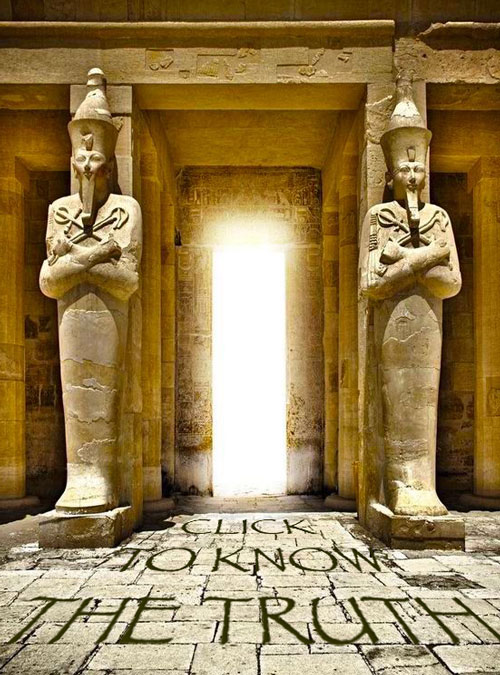The Birth of Egypt
Solar eclipses are significant conjunctions.

When the lunar disc “occults” the solar disc during an eclipse it happens when the Sun, the Moon and the Earth have the same elliptical longitude. When this new moon eclipses the vernal equinox sun the energy of REBIRTH can be profoundly felt on Earth. This implied that the Zep Tepi calendar began with the ultimate quadfecta: Leo rising due east—on the vernal equinox—before a total solar eclipse—at noon.
But was there such a conjunction? Finding a solar eclipse on the vernal equinox is one thing, but we also needed a point of reference outside the solar system. If we accept Thotmoses IV’s Dream Stele that the Sphinx was built upon the “Holy Place of Zep Tepi” then the Hermetic phrase “as above, so below” gives us a clue that a star alignment once marked the start of the Royal Calendar.

Above: moments before sunrise on the eastern horizon over 11,000 years ago
Although Leo is associated with the heart and with the Sun in astrology, astronomy reinforces this idea because Regulus follows the Sun’s path on the ecliptic. Due to the fact that this star moves just like a “mini Sun” and also remains the brightest in the constellation of Leo, it carries the title “Little King”. So what era reflects the image above? Well, about -9,100 in astronomical units. If we transition anywhere outside this time frame, Leo (with its belly on the horizon) rises away from Azimuth 90°.

Above: a noon solar eclipse in Leo on the vernal equinox
By rocking the sky backwards and forwards with Stellarium we can search for solar eclipses on the vernal equinox in Leo that might suit our start date of -9,100. Sure enough, we can infer a conjunction at midday on March 20, -9,124. Converting this to our calendar the starting year of The Royal Calendar then becomes:
» 9,125 BCE «
Although programs like Stellarium can be illuminating, we must take into account the shorter tropical year when dealing with these vast time spans. This shortfall of about 0.0078 days results in the date slipping by several months over 11,000 years. In the screenshot above, Stellarium mistakenly shows a “vernal equinox” on 2/6/-9,124.

Above: Leo rises in the east as Aquarius sinks in the west
So this lunar, solar and stellar conjunction in 9,125 BCE marked the beginning of time. A few months later the Nile would flood upon the helical rising of Sirius and the Sothic cycle would commence. To celebrate this astronomical “Schelling Point,” our ancestors carved a massive monument from the living limestone that eventually became an enduring icon. While the Sun and stars once held the eyes of the Sphinx, it was the Moon that swelled our hearts to these conjunctions.
During this period the summer solstice was in Leo—the time of the Sun’s greatest power. So as the northern Royal Star, Regulus marked midsummer. Astrology’s traditional view of Regulus aligns this star with amazing qualities—the eighth chakra or the Soul Star. The number 23 was related to the Royal Star of the Lion because on August 23 Regulus conjuncts the Sun.

During an eclipse, this profound feeling of REBIRTH guided the shamans who seeded this wisdom for future generations. While this golden age has been washed away, its influences are still apparent when we look to the heavens. Once upon a time, Leo and Aquarius brought together “big heart” and “big mind” as polarities on opposite sides of the zodiac. This union of fire and water once resulted in a generous culture with an inquisitive nature.
Diametrical signs are really like two sides of the same coin—they are concerned with identical issues but are just oriented in opposite directions. Both houses are concerned with creativity, progress and expression yet approach them quite differently: Leo deals with these issues from a PERSONAL standpoint while Aquarius addresses these concerns from a COLLECTIVE point of view. As we enter this new age we will revisit many of the same dramas from our past albeit from a contrary perspective.

Over 11,000 years ago Egypt was subject to the deluges. The glaciers were melting and the Earth was coming to life after a long ice age—it was a time of rebirth. This was due to the new active cycle of the Sun which would even result in the Nile flowing north and not west. These torrential rains would also leave their erosional legacy around the Sphinx enclosure and imply that it was built before the pyramids. For “barbarians” to have measured time in this way takes a level of sophistication that boggles the mind.

Above: the Sphinx was built at a time of extreme precipitation and climate change
Although the fertile legacy of Egypt was eventually obscured, this era was a high water mark in human history because the wisdom of the Milky Way informed the Nile directly. During this golden age of the Shemsu Hor, the river temples were mapped and the gods were named. Where there had only been forts or ports in parts of the country, now there emerged towns with their own unique influences. Egypt matured as a cultural, trading and spiritual centre and began to develop artistic, mercantile and religious classes.
Four Sothic cycles later in 3,281 BCE this pre-dynastic period would come to an end and Egypt would take its first steps towards unification. As the First Dynasty emerged however, the gods themselves would be muddied as the Nile deviated from the Milky Way. As esoteric Egypt became exoteric Egypt, the climate transitioned from wet to dry and the culture moved from matriarchal to patriarchal. Eventually, the country became a caricature of itself. As John Anthony West put it:

Egyptian civilisation was not a development, it was a legacy.
